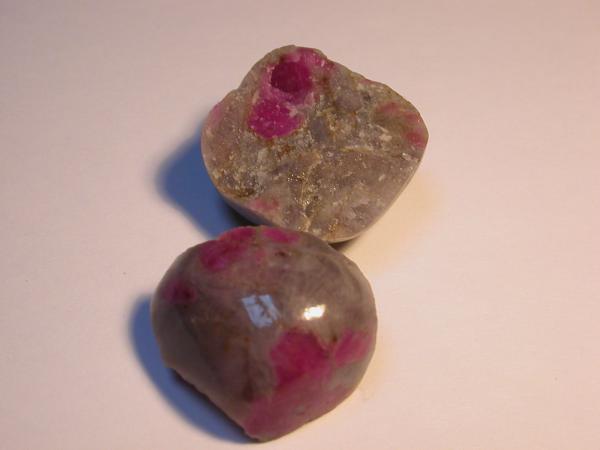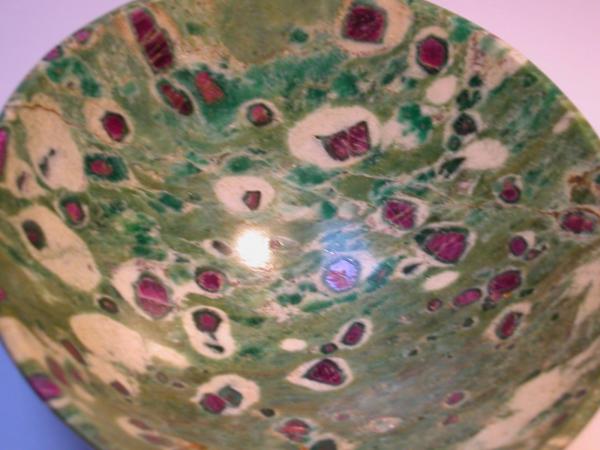John S. White
Site Admin

Joined: 04 Sep 2006
Posts: 1298
Location: Stewartstown, Pennsylvania, USA



|
 Posted: Oct 17, 2008 12:04 Post subject: Ruby corundum and cordierite from Ganjam, Orissa, India Posted: Oct 17, 2008 12:04 Post subject: Ruby corundum and cordierite from Ganjam, Orissa, India |
|
|
At the Denver Show this past September, I saw an interesting new gem rock (if I may). We are all familiar with ruby corundum in green zoisite from Tanzania and ruby corundum in green muscovite (“fuchsite”) from Hassan, Mysore, India, but this new material consists of crystals of ruby corundum in a not unattractive gray matrix. The dealer who had this material was Matrix India, M. F. Makki and Sammi Makki, from Pune (Poona), India. All that they had was in the form of small (circa 2 to 4 cm) polished nodules and the locality was given as Ganjam, Orissa, India. I was given a piece for identification as they, and I, had no idea what the gray mineral was.
The piece in the photo below looks browner that it actually is. The cordierite is really gray in color.
Some of us are fortunate in having good friends who possess particular skills in mineral identification, and the necessary equipment to allow appropriate testing. My friend Peter Leavens is one of those and he very graciously agreed to examine this material. Here is what he had to report:
_______________________________________________
Ruby corundum and cordierite from Ganjam, Orissa, India
Peter B. Leavens
Department of Geosciences
University of Delaware
Newark DE 19716
Samples of a new find of ruby corundum in matrix from Ganjam, Orissa state, India, were available at the Denver show. This note is based on examination of a roughly polished piece about 1.5 cm across. The corundum, in grains up to one cm across, is a pleasing raspberry-red. Fractured grains show distinct polysynthetic twinning and prominent rhombohedral parting. The matrix is a pale gray with a very slightly bluish tinge. X-ray diffraction analysis showed it to be cordierite. Observed by polarized light microscopy the cordierite is in fine granular aggregates with grains averaging a few tenths of a mm across; individual grains show zoned extinction. The beta index of refraction is about 1.532, toward the low end for cordierite.
Corundum + cordierite are stable in Fe-poor rocks subjected to contact or regional metamorphism at temperatures above 535° C. at 2 kb water pressure to above 665° C. at 7 kb water pressure relative to chlorite + aluminum silicate (andalusite, sillimanite, or kyanite) (Siefert, 1973). The familiar corundum + zoisite assemblage occurs in more calcium-rich rocks. The corundum + cordierite assemblage from Ganjam formed at medium to high grade metamorphism, above 535° C, in a rock high in Mg relative to Fe and Ca.
Siefert, F. (1973) Stability of the assemblage cordierite-corundum in the system MgO- Al2O3-SiO2-H2O. Contributions to Mineralogy and Petrology, 41, 171-177
| Description: |
| Cordierite and ruby corundum nodule |
|
| Viewed: |
10601 Time(s) |

|
| Description: |
| Ruby corundum and fuchsite bowl |
|
| Viewed: |
10526 Time(s) |

|
_________________
John S. White
aka Rondinaire |
|




